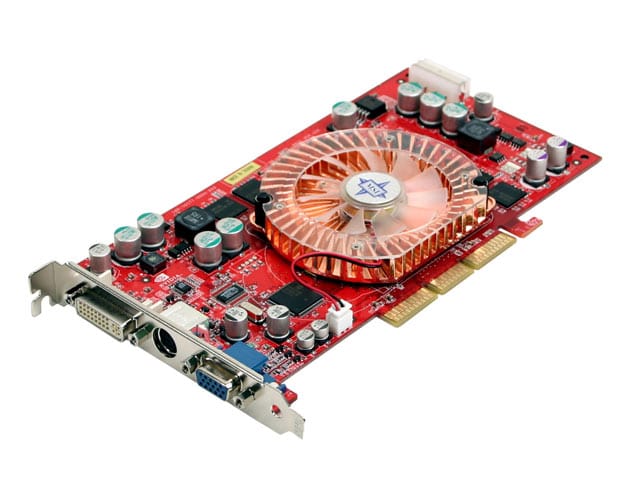1st part: GeForce FX 5900 and RADEON 9800: ASUS, Chaintech and Gainward versus Sapphire.
2nd part: Test system and test conditions. Testing. Overclocking. Conclusion.
The current performance leaders in the competition between ATI and NVIDIA among gaming video chips are R350 and NV35, which were officially named ATI RADEON 9800 Pro and NVIDIA GeForce FX 5900 Ultra. Accordingly, video cards based on NVIDIA GeForce FX 5900 Ultra and ATI RADEON 9800 PRO are at the top end of the price range for high-end gaming video cards – their prices start around $ 400. for a fee. In the most “extreme” cases, the prices of such video cards can reach the phenomenal level of 1000 USD, like a video card from Gainward with a water cooling system.
However, “High-end” is not only video cards based on GeForce FX 5900 Ultra and RADEON 9800 PRO. Some time after the announcement of high-performance versions of NV35 and R350, NVIDIA and ATI announced the release of slightly slower versions of “top-end” motherboards. We are talking about NVIDIA GeForce FX 5900 and ATI RADEON 9800. They are based on the same NVIDIA NV35 and ATI R350, but differ from more efficient versions by lower frequencies and, in the case of GeForce FX 5900, by a reduced video memory.
More details:
Video cards based on NVIDIA GeForce FX 5900 have a GPU clock speed 400 MHz, while NVIDIA GeForce FX 5900 Ultra – 450 MHz… The video memory frequency of the GeForce FX 5900 and GeForce FX 5900 Ultra is the same and amounts to 850 (425 DDR) MГцhowever, the GeForce FX 5900 has only 128 MB video memory while GeForce FX 5900 Ultra – 256 MB video memory.
ATI RADEON 9800 differs from ATI RADEON 9800 PRO in lower frequencies of the graphics core and video memory: in the RADEON 9800 they are 325/580 (290 DDR) MHz, а у RADEON 9800 PRO – 380/680 (340 DDR) MHz.
There are 2 variants of video cards based on the RADEON 9800 PRO – with 128 MB of video memory and 256 MB of DDR-II memory, but boards with DDR-II are much less widespread, since they are produced in limited editions and have a much higher cost with a very insignificant advantage in terms of speeds over 128MB options.
In today’s review we will look at several models of video cards based on NVIDIA GeForce FX 5900 and compare their performance with the ATI rival RADEON 9800. In addition, we will assess the lag of the GeForce FX 5900 and RADEON 9800 from their more productive counterparts and see how the situation changes when overclocked. In order to make the comparison more interesting, I used both regular and non-standard game tests for testing.
As “experimental” motherboards based on NVIDIA GeForce FX 5900, I took three models from well-known manufacturers at once, ASUS, Chaintech and Gainward, and the RADEON 9800 presented a motherboard made by Sapphire. So let’s go!
ASUS V9950
The ASUS board comes in a large cardboard box with an impressive high-tech collage on the front:
In addition to the board, the package includes an S-Video -> RCA adapter cable, a DVI-> D-Sub adapter, a cable for connecting an additional power supply, a user manual and an impressive stack of CDs with drivers, utilities and games. mentions of Black Hawk Down and Gun Metal:
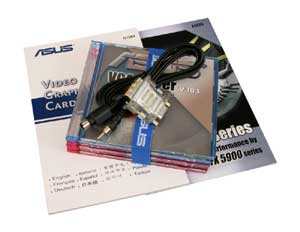
The video card is made according to the reference design NVIDIA GeForce FX 5900/5900 Ultra and differs from the “Ultra” version by the absence of memory chips on the reverse side:
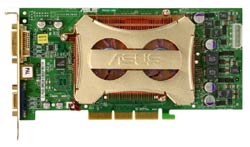
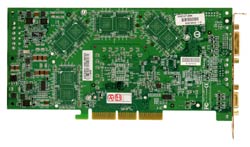
ASUS V9950 has a standard set of connectors: D-Sub, DVI-I and S-Video:
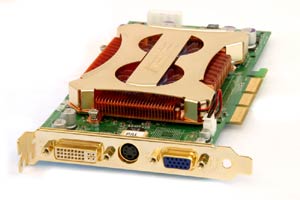
Like all video cards based on NVIDIA GeForce FX 5900/5900 Ultra, the board has a connector for connecting an additional power supply. If you turn on the system without connecting power to this connector, the board will start up, but will operate at lower frequencies:

The basis of the ASUS V9950 is an NVIDIA GeForce FX 5900 graphics processor and 128 MB of DDR SDRAM from Hynix with a cycle time of 2.2 ns:
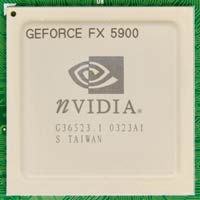
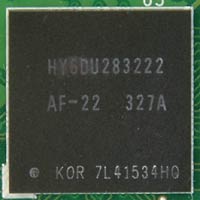
The clock speed of the graphics processor is 400 MHz, the video memory is 850 MHz.
The built-in GPU is responsible for the output of the image to the TV-Out connector, but an external DVI transmitter from Silicon Image provides the formation of a digital signal for connecting monitors via the DVI connector:
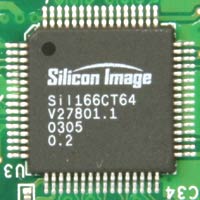
At the first meeting, the board left a double impression. On the one hand, there is a pleasant design, a high-quality and not too noisy two-fan copper cooler, which immediately covers the memory chips and the graphics processor and at the same time has good thermal contact with all elements. On the other hand, there is an awkward bar with the company logo covering more than half of the area above the fans, which reduces the efficiency of the cooling system and increases the noise level.
Another unpleasant moment – in games, the board emits a quiet but distinct chirp, which coincides with the frame rate. As far as I was able to determine, the coils in the GPU power regulators “chirp”.
However, as it turned out, all the video cards based on NVIDIA GeForce FX 5900/5900 Ultra, which took part in the review, have this drawback to one degree or another.
Chaintech A-FX98
The video card from Chaintech is packed in a solid box, which depicts a certain warrior with an incomprehensible menacing weapon in his hands:
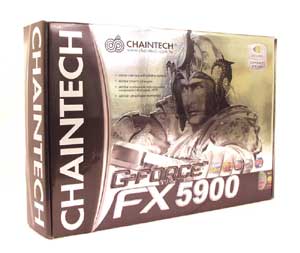
The board package contains an S-Video cable, an RCA cable, a DVI-I-> D-Sub adapter, a cable for connecting an additional power supply, a user’s manual, and a set of CDs with drivers and utilities
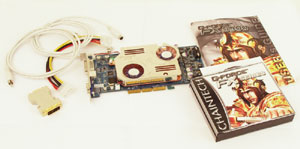
The board is made according to the reference design from NVIDIA and differs from the previous one only in the color of the PCB and the cooler design:
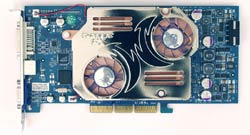
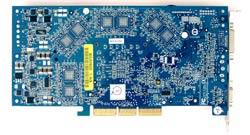
Chaintech A-FX98 has D-Sub, DVI-I outputs and a combined video input-video output connector:
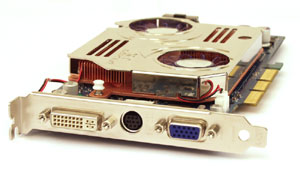
The connector for connecting additional power is now deployed and “laid” on the textolite – this method of fastening is more reliable:
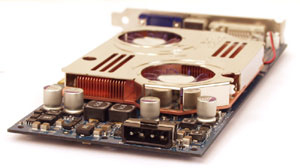
The cooler on Chaintech A-FX98 is made in the same way as the cooler on a video card from ASUS: a copper base to which thin copper plates are glued or soldered. However, here nothing prevents the air flow to the fans:
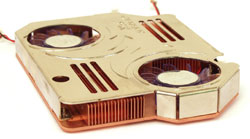
On the “bottom” of the cooler, there are pads that are in contact with the video memory chips through adhesive heat-conducting pads:
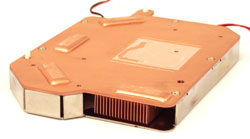
Chaintech’s motherboard is based on the NVIDIA GeForce FX 5900 chip (apparently, the chip came from early shipments, since it is also marked as “NV35”) and 128 MB of DDR SDRAM in Hynix chips with a cycle time of 2.2 ns:
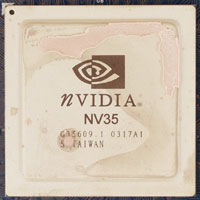
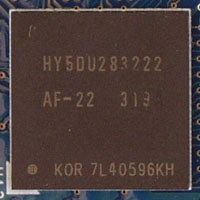
The nominal clock frequencies of the GPU and video memory are standard: 400/850 (425DDR) MHz.
The TV-out signal conditioning is provided by the integrated GPU, while the TV signal decoding and digital signal conditioning for the DVI-I connector on the Chaintech board are provided by an external SAA7114 chip from Philips and a DVI transmitter from Silicon Image:
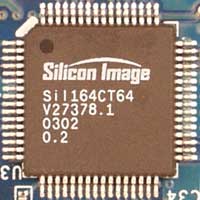
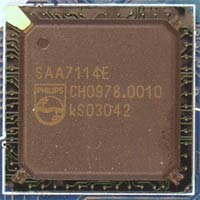
The A-FX98 video card from Chaintech left a pleasant impression with low noise level and low temperature during operation. The chatter of the stabilizer coils has diminished compared to the ASUS motherboard, but it hasn’t disappeared.
Gainward FX PowerPack! Model Ultra/1200 XP “Golden Sample”
The box with a video card from Gainward based on GeForce FX 5900 is designed in an extremely peaceful manner:
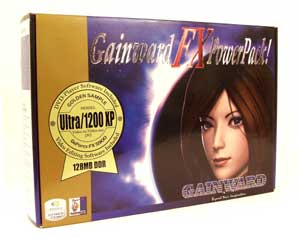
The delivery package of the board from Gainward includes an adapter cable from a combined video input-video output connector to 2 S-Video and 2 RCA, a DVI-I-> D-Sub adapter, a cable for connecting an additional power supply, a user manual, a “proprietary” nameplate from Gainward and a set of CDs with drivers and utilities:
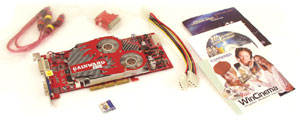
The board is made according to the reference design NVIDIA GeForce FX 5900/5900 Ultra:
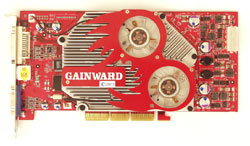
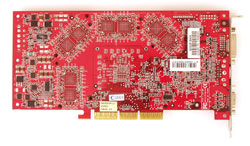
Gainward FX PowerPack video card! Model Ultra / 1200 XP “Golden Sample” is equipped with a D-Sub, DVI-I connector and a combined video input-video output connector:
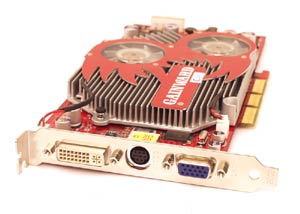
Like all video cards based on NVIDIA GeForce FX 5900/5900 Ultra, the board from Gainward requires additional power supply:
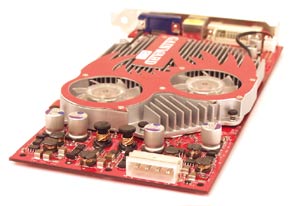
The cooling system on the board is a massive aluminum heatsink covering both the graphics processor and memory chips. The radiator has two fans with backlight LEDs:
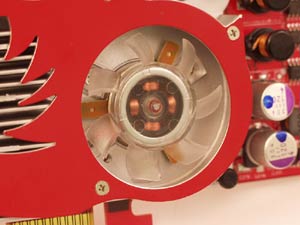
Gainward FX PowerPack! Model Ultra / 1200 XP “Golden Sample” is the “brightest” video card that has been in our test lab, it will appeal to fans of such delights:
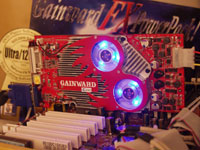
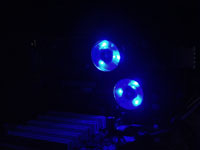
The basis of the board is an NVIDIA GeForce FX 5900 chip and 128 MB of video memory in DDR SDRAM chips from Hynix with a cycle time of 2.2 ns. The graphics processor installed on the video card was released even before the official announcement, so it is only labeled “NV35”:
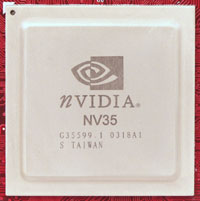
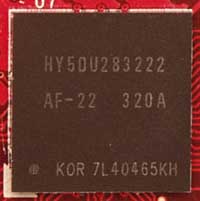
Nominal clock frequencies of the core / video memory – 400/850 (425 DDR) MHz.
Interestingly, to generate a signal on DVI, the board does not use the usual DVI-transmitter from Silicon Image, but a similar chip from THine Electronics with an increased conversion frequency – 170 MHz. The TV signal is encoded by an onboard GPU and decoding is provided by Philips’ popular SAA7108 chip:
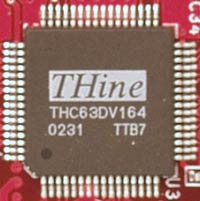
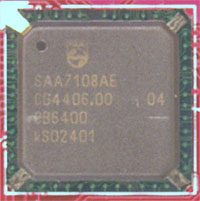
I liked the board from Gainward more than others – despite the fact that it has a slightly higher noise level from the cooler, the “chirping” of the power supply stabilizer coils appears only during overclocking and only in “heavy” modes, and the now fashionable “blue” illumination pleases the eye …
So, having briefly familiarized ourselves with the features of the new boards, let’s move on to testing.
1st part: GeForce FX 5900 and RADEON 9800: ASUS, Chaintech and Gainward versus Sapphire.
2nd part: Test system and test conditions. Testing. Overclocking. Conclusion.





